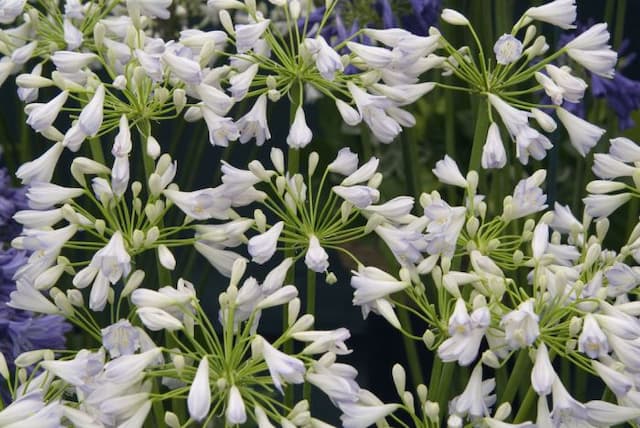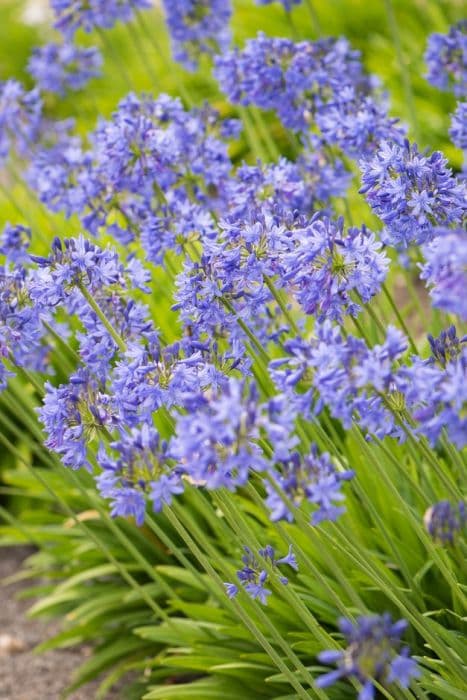Lily of the Nile Agapanthus 'Purple Delight'

ABOUT
Agapanthus 'Purple Delight', commonly known as Lily of the Nile or African Lily, is a striking plant known for its vibrant floral display. It forms a clump of arching, glossy green leaves that create a lush, grassy backdrop for the true stars of the show: the flowers. These blossoms appear on tall, sturdy stems that rise above the foliage, culminating in large, spherical clusters of trumpet-shaped flowers. The flowers of 'Purple Delight' are a stunning deep purple hue, providing a rich pop of color in the garden. The individual blooms are composed of six petals that gracefully flare outwards, revealing a lighter purple or sometimes almost blue interior. These flowers are particularly attractive to pollinators such as bees and butterflies, and they make excellent cut flowers for indoor arrangements as well. Outside of blooming season, the plant's long, strappy leaves continue to offer a verdant, evergreen presence in the landscape.
About this plant
 Names
NamesFamily
Amaryllidaceae.
Synonyms
Lily of the Nile, African Lily, African Blue Lily.
Common names
Agapanthus 'Purple Delight'.
 Toxicity
ToxicityTo humans
Agapanthus, commonly known as Lily of the Nile, contains several toxic compounds that can be harmful if ingested. If parts of the plant are consumed, it may cause symptoms such as nausea, vomiting, and diarrhea. Additionally, the sap contains skin irritants that can cause dermatitis in sensitive individuals upon contact.
To pets
Lily of the Nile is toxic to pets, including dogs and cats. Ingesting any part of the plant can lead to symptoms such as nausea, vomiting, diarrhea, and abdominal pain. In severe cases, it could potentially lead to more serious consequences such as tremors or cardiac issues. If you suspect your pet has ingested this plant, contact a veterinarian promptly.
 Characteristics
CharacteristicsLife cycle
Perennials
Foliage type
Evergreen
Color of leaves
Green
Flower color
Purple
Height
2 feet (60 cm)
Spread
2 feet (60 cm)
Plant type
Bulb
Hardiness zones
8
Native area
South Africa
Benefits
 General Benefits
General Benefits- Enhances garden aesthetics: It has striking purple flowers that add color and visual interest to garden spaces.
- Attracts pollinators: The blooms of the Agapanthus 'Purple Delight', commonly known as African Lily, attract bees and butterflies, benefiting the pollination of surrounding plants.
- Drought-tolerant: Once established, the African Lily is relatively drought-tolerant, making it suitable for xeriscaping and low-water gardens.
- Low maintenance: This plant requires minimal care once established, needing only occasional watering and fertilization.
- Versatile planting options: African Lily can be planted in borders, as a focal point, or in containers, offering flexibility in landscape design.
- Long blooming period: The plant has a long flowering season, providing color and interest throughout the warmer months.
- Deer resistant: Its foliage and flowers are not a preferred food source for deer, making it a good choice for gardens in areas with deer pressure.
- Frost hardiness: The African Lily can withstand mild frosts, making it suitable for a range of climates.
 Medical Properties
Medical PropertiesThis plant is not used for medical purposes.
 Air-purifying Qualities
Air-purifying QualitiesThis plant is not specifically known for air purifying qualities.
 Other Uses
Other Uses- Lily of the Nile can be used as a natural dye, with the flowers potentially creating shades of blue or purple for textiles.
- Lily of the Nile's strong, fibrous leaves can be woven into small baskets or decorative items by crafters.
- The sap from Lily of the Nile can be used as a mild adhesive for paper crafts or as a binding agent for natural pigments.
- The long-lasting flowers of Lily of the Nile make for a reliable source of decorations in dried flower arrangements.
- Lily of the Nile can be planted to stabilize soil and prevent erosion on slopes due to its robust root system.
- The flowers of Lily of the Nile can serve as a pH indicator, changing color in response to acidity or basicity of solutions they come in contact with.
- When planted in large clusters, Lily of the Nile can be used as a privacy screen due to its foliage and flower height.
- The seeds of Lily of the Nile can be used in jewellery making, often incorporated into necklaces or bracelets.
- Lily of the Nile can be incorporated into a sensory garden for its striking visual appeal and unique texture that can be experienced through touch.
- The robust nature of Lily of the Nile makes it suitable as a living barrier to define outdoor spaces or garden paths.
Interesting Facts
 Feng Shui
Feng ShuiThe Agapanthus, commonly known as Lily of the Nile, is not used in Feng Shui practice.
 Zodiac Sign Compitability
Zodiac Sign CompitabilityThe Lily of the Nile is not used in astrology practice.
 Plant Symbolism
Plant Symbolism- Love Letters: The name Agapanthus is derived from the Greek words 'agape' meaning love, and 'anthos' meaning flower. Therefore, it symbolizes love letters or a message of love.
- Beauty: The striking 'Purple Delight' variety, with its rich purple color, represents beauty and admiration.
- Endurance: Agapanthus is known for being hardy and able to withstand tough conditions, making it a symbol of endurance and strength.
- Fertility: In some cultures, the abundant flowers of the Agapanthus plant are seen as a symbol of fertility and creation.
- Protection: The shape and form of the Agapanthus, forming an umbrella-like cluster, can be viewed as offering protection or a safe haven.
 Water
WaterFor an African Lily, known commonly as Agapanthus 'Purple Delight', watering should be done moderately to maintain moist but not soggy soil during the growing season. In general, water the plant deeply once a week, providing about 1 gallon of water per plant. Cut back on watering in the winter when the plant is dormant, reducing to about half a gallon every two weeks to prevent root rot. Ensure that the plant has good drainage and adjust the frequency of watering based on the temperature and humidity, watering more often in hot, dry conditions.
 Light
LightAgapanthus 'Purple Delight', also known as African Lily, thrives best in full sun to partial shade. It should be placed in a location where it receives at least 6 hours of direct sunlight daily. However, in extremely hot areas, it benefits from some afternoon shade to protect the leaves and flowers from scorching.
 Temperature
TemperatureThe African Lily or Agapanthus 'Purple Delight' prefers temperatures between 50°F and 80°F for optimal growth. It can tolerate minimum temperatures down to about 20°F but should be protected from frost. The ideal conditions are in an area where the temperature does not frequently drop below freezing, as cold temperatures can damage the foliage and roots.
 Pruning
PruningPrune the African Lily, or Agapanthus 'Purple Delight', to remove spent flower stalks after blooming to encourage a tidy appearance and potentially a second bloom. Cut back foliage only after it has died back naturally in the fall or early spring. The best time for pruning is when the flowers have faded and before the onset of winter.
 Cleaning
CleaningAs needed
 Soil
SoilLily of the Nile prefers a well-draining soil mix rich in organic matter, with a pH range of 6.0 to 8.0. A mixture of two parts loam, one part perlite or sand, and one part compost or well-rotted manure is ideal for this plant.
 Repotting
RepottingLily of the Nile should be repotted every two to three years to ensure it has enough room for growth and to refresh the soil, ensuring better health and blooming.
 Humidity & Misting
Humidity & MistingLily of the Nile thrives in typical room humidity levels; however, if the air is too dry, especially in winter, a light misting can be beneficial.
 Suitable locations
Suitable locationsIndoor
Place Lily of the Nile in bright light and well-draining soil indoors.
Outdoor
Grow Lily of the Nile in sun or part-shade with well-draining soil.
Hardiness zone
Lily of the Nile is hardy in USDA zones 8-11.
 Life cycle
Life cycleAgapanthus 'Purple Delight', commonly known as Lily of the Nile, begins its life cycle as a seed, which upon germination grows into a seedling with strap-like leaves. The seedling then develops into a vegetative plant that forms a clump with fleshy roots. As it matures, it produces long, sturdy stalks topped with spherical clusters of trumpet-shaped purple flowers during the summer months. After pollination, typically by bees or other insects, the flowers give way to seed capsules if conditions are favorable. The plant then enters a dormant phase in colder weather, with the foliage dying back if exposed to frost, to conserve energy until the next growing season. With each subsequent season, the plant size can increase, and it can be propagated by dividing the root clump before it resumes its growth cycle in spring.
 Propogation
PropogationPropogation time
Spring-Early Summer
The most popular method of propagating the Agapanthus 'Purple Delight', commonly known as African Lily, is by division. This is usually done in the late spring after the threat of frost has passed or in the early fall. You start by carefully digging up the parent plant, making sure to lift as much of the root ball as possible to avoid damage. The clumps are then gently separated by hand or with a sharp knife, ensuring each division has a portion of the roots and at least one or two growing points or shoots. These divisions are then replanted at the same soil depth they were growing at previously, spaced about 18 inches (approximately 45 centimeters) apart to allow for adequate growth and air circulation. Water the new divisions thoroughly after planting to help establish them.








![African lily [Brilliant Blue]](/_next/image?url=https%3A%2F%2Fplants-admin.emdemapps.com%2Fimages%2Fplants%2F%2Fimages%2F604b5e3c28e2b.png&w=640&q=75)
